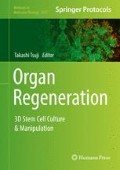Abstract
Pluripotent stem cells (PSCs) possess self-organizing abilities in 3D culture. This property has been demonstrated in recent studies, including the generation of various neuroectodermal and endodermal tissues. For example, PSCs are able to differentiate into specific type of neural tissues, such as the neocortex and the optic cup, in response to local positional information brought about by signals during embryogenesis. In contrast, the generation of cerebellar tissue from PSCs requires a secondary induction by a signaling center, called the isthmic organizer, which first appears in the cell aggregate in 3D culture. Such developmental complexity of cerebellum has hampered establishment of effective differentiation culture system from PSCs, thus far.
We recently reported that cerebellar neurons are generated from human PSCs (hPSCs). In this chapter, we describe an efficient protocol for differentiation of 3D cerebellar neuroepithelium from hPSCs. We also describe the protocols for further differentiation into specific neurons in the cerebellar cortex, such as Purkinje cells and the granule cells.
Access this chapter
Tax calculation will be finalised at checkout
Purchases are for personal use only
References
Bird MJ, Needham K, Frazier AE et al (2014) Functional characterization of Friedreich ataxia iPS derived neuronal progenitors and their integration on the adult brain. PLoS One 9:e101718
Eigentler A, Boesch S, Schneider R et al (2013) Induced pluripotent stem cells from Friedreich ataxia patients fail to upregulate frataxin during in vitro differentiation to peripheral sensory neurons. Stem Cells Dev 22:3271–3282
Hick A, Wattenhofer-Donzé M, Chintawar S et al (2013) Neurons and cardiomyocytes derived from induced pluripotent stem cells as a model for mitochondrial defects in Friedreich’s ataxia. Dis Model Mech 6:608–621
Koch P, Breuer P, Peitz M et al (2011) Excitation-induced ataxin-3 aggregation in neurons from patients with Machado-Joseph disease. Nature 480:543–546
Ku S, Soragni E, Campau E et al (2010) Friedreich’s ataxia induced pluripotent stem cells model intergenerational GAA∙TTC triplet repeat instability. Cell Stem Cell 7:631–637
Watson LM, Wong MMK, Becker EB (2015) Induced pluripotent stem cell technology for modeling and therapy of cerebellar ataxia. Open Biol 5:150056
Wiethoff S, Arber C, Li A et al (2015) Using human induced pluripotent stem cells to model cerebellar disease: hope and hype. J Neurogenetics 29:95–102
Zervas M, Blaess S, Joyner AL (2005) Classical embryological studies and modern genetic analysis of midbrain and cerebellum development. Curr Topic Dev Biol 69:101–138
Nakamura H, Katahira T, Matsunaga E et al (2005) Isthmus organizer for midbrain and hindbrain development. Brain Res Brain Res Rev 49:12–126
Muguruma K, Nishiyama A, Ono Y et al (2010) Ontogeny-recapitulating generation and tissue integration of ES cell-derived Purkinje cells. Nat Neurosci 13:1171–1180
Muguruma K, Nishiyama A, Kawakami H et al (2015) Self-organization of polarized cerebellar tissue in 3D culture of human pluripotent stem cells. Cell Rep 10:537–550
Author information
Authors and Affiliations
Corresponding author
Editor information
Editors and Affiliations
Rights and permissions
Copyright information
© 2017 Springer Science+Business Media LLC
About this protocol
Cite this protocol
Muguruma, K. (2017). 3D Culture for Self-Formation of the Cerebellum from Human Pluripotent Stem Cells Through Induction of the Isthmic Organizer. In: Tsuji, T. (eds) Organ Regeneration. Methods in Molecular Biology, vol 1597. Humana Press, New York, NY. https://doi.org/10.1007/978-1-4939-6949-4_3
Download citation
DOI: https://doi.org/10.1007/978-1-4939-6949-4_3
Published:
Publisher Name: Humana Press, New York, NY
Print ISBN: 978-1-4939-6947-0
Online ISBN: 978-1-4939-6949-4
eBook Packages: Springer Protocols

